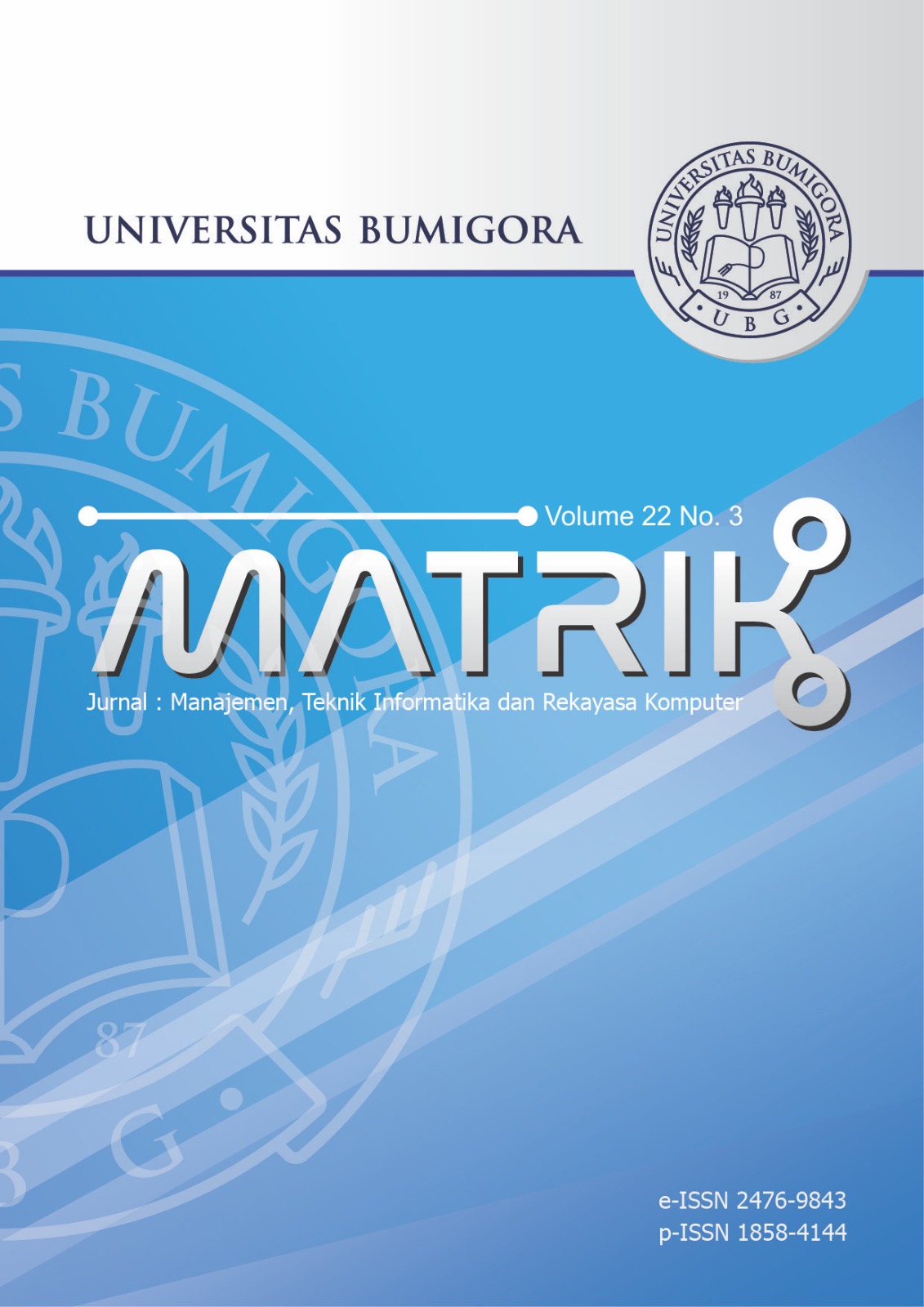Digital Forensic Analysis of WhatsApp Business Applications on Android-Based Smartphones Using NIST
DOI:
https://doi.org/10.30812/matrik.v22i3.3033Keywords:
Android, Digital Evidence, Digital Forensics, MOBILedit, National Institute of Standards and Technology, WhatsApp BusinessAbstract
WhatsApp Business is an Android application that can be downloaded on Playstore to serve small business owners. This provides an opportunity for criminals to take advantage of the app’s features. These crimes can take the form of fraud, misdirection, and misuse of applications, so digital forensics is necessary because there has never been any research that has done this. This study aims to obtain digital evidence and is carried out on Android smartphones with the WhatsApp Business application installed with four scenarios tested. This study uses the NIST SP 800-101 Rev 1 guidelines with four stages: preservation, acquisition, inspection & analysis, and reporting. The forensic method used is static forensics using the MOBILedit forensic express forensic tools and SysTools SQLite Viewer. The results of this study in scenario 1, by not deleting, get a 100% percentage. Then, scenario 2, namely direct write-off, gets a percentage of 71%. Furthermore, scenario 3, namely uninstalling the application, does not get digital evidence, and scenario 4, namely deleting data through the application manager, also does not get any evidence. The contribution of this research is expected to be a reference in uncovering cases in the WhatsApp Business application with digital forensics.
Downloads
References
[2] D. Curry, “Android Statistics (2022),†BusinessofApps, 2022. https://www.businessofapps.com/data/android-statistics/ (accessed Dec. 19, 2022).
[3] WhatsApp, “Apa Itu Aplikasi WhatsApp Business?†https://faq.whatsapp.com/641572844337957/?locale=id_ID (accessed Apr. 01, 2023).
[4] D. Astria, M. Santi, and S. Muhammadiyah Tulungagung, “Pemanfaatan Aplikasi Whatsapp Bisnis Dalam Strategi Pemasaran Online Untuk Meningkatkan Jumlah Penjualan,†Tulungagung, Dec. 2021. [Online]. Available: http://ejournal.staim-tulungagung.ac.id/index.php/Eksyar
[5] L. Ceci, “Number of WhatsApp Business downloads worldwide from 2018 to 2021 (in millions),†Statista, Jan. 2023, Accessed: Apr. 01, 2023. [Online]. Available: https://www.statista.com/statistics/1305771/whatsapp-business-downloads-worldwide/
[6] Stephanie Chevalier, “Countries with the highest number of WhatsApp Business app downloads as of June 2022(in millions),†Statista, Jan. 27, 2023. https://www.statista.com/statistics/1276030/whatsapp-business-downloads-leading-countries/ (accessed Apr. 01, 2023).
[7] Raymond SM Tampubolon and Akhmad Zaenuddin, “Status Hukum Interaksi Bisnis Melalui WhatsApp,†KABAR24, Nov. 09, 2020. https://kabar24.bisnis.com/read/20201109/16/1315273/status-hukum-interaksi-bisnis-melalui-whatsapp (accessed Apr. 01, 2023).
[8] Mohammad Faruq Afif, “Metode Clustering Storage untuk Penyimpanan Bukti Digital Menggunakan Software Defined Storage,†Universitas Islam Indonesia, Oct. 16, 2019. https://dspace.uii.ac.id/handle/123456789/18258 (accessed Apr. 01, 2023).
[9] R. Tamma, O. Skulkin, H. Mahalik, and S. Bommisetty, “Practical Mobile Forensics: Forensically investigate and analyze iOS, Android, and Windows 10 devices,†2014.
[10] ANGGIS TIYANA BR SITUNGKIR, “Tinjauan Yuridis Terhadap Digital Forensik Dalam Menganalisis Barang Bukti Digital Dalam Pembuktian Tindak Pidana Ditinjau Dari Undang-Undang No 11 Tahun 2008 Junto Undang-Undang No 19 Tahun 2016 Tentang Informasi Dan Transaksi Elektronik,†2018.
[11] H. Arshad, A. Bin Jantan, and O. I. Abiodun, “Digital forensics: Review of issues in scientific validation of digital evidence,†Journal of Information Processing Systems, vol. 14, no. 2, pp. 346–376, 2018, doi: 10.3745/JIPS.03.0095.
[12] X. Zhang, K.-K. Raymond, and C. Editors, “Forensic Education An Experiential Learning Approach,†2019. Accessed: Dec. 11, 2022. [Online]. Available: http://www.springer.com/series/11970
[13] M. N. Al-Azhar, “Digital Forensic,†Jakarta: Puslabfor Bareskim Polri, 2012.
[14] R. Stoykova, “Digital evidence: Unaddressed threats to fairness and the presumption of innocence,†Computer Law and Security Review, vol. 42, Sep. 2021, doi: 10.1016/j.clsr.2021.105575.
[15] M. S. Jafri, S. Raharjo, and M. R. Arief, “Implementation of ACPO Framework for Digital Evidence Acquisition in Smartphones,†vol. 15, no. 1, 2022.
[16] R. Ayers, S. Brothers, and W. Jansen, “Guidelines on mobile device forensics,†Gaithersburg, MD, May 2014. doi: 10.6028/NIST.SP.800-101r1.
[17] A. Yudhana, “Perbandingan Tool Forensik pada Mozilla Firefox Private Mode Menggunakan Metode NIST.†[Online]. Available: http://jurnal.itg.ac.id/
[18] I. Riadi, “PERBANDINGAN TOOL FORENSIK DATA RECOVERY BERBASIS ANDROID MENGGUNAKAN METODE NIST,†Jurnal Teknologi Informasi dan Ilmu Komputer (JTIIK), vol. 7, no. 1, pp. 197–204, 2020, doi: 10.25126/jtiik.202071921.
[19] M. Dweikat, D. Eleyan, and A. Eleyan, “Digital Forensic Tools Used in Analyzing Cybercrime,†Journal of University of Shanghai for Science and Technology, vol. 23, no. 3, Mar. 2021, doi: 10.51201/Jusst12621.
[20] A. N. Ichsan and I. Riadi, “Mobile Forensic on Android-based IMO Messenger Services using Digital Forensic Research Workshop (DFRWS) Method,†Int J Comput Appl, vol. 174, no. 18, pp. 34–40, Feb. 2021, doi: 10.5120/ijca2021921076.
[21] I. Riadi, H. Herman, and N. H. Siregar, “Mobile Forensic of Vaccine Hoaxes on Signal Messenger using DFRWS Framework,†MATRIK : Jurnal Manajemen, Teknik Informatika dan Rekayasa Komputer, vol. 21, no. 3, pp. 489–502, Jul. 2022, doi: 10.30812/matrik.v21i3.1620.
[22] K.D.O Mahendra and I.K.A Mogi, “Digital Forensic Analysis of Michat Applications on Android as Digital Proof in Handling Online Prostitution Cases,†Jurnal Elektronik Ilmu Komputer Udayana , vol. Volume 9 No. 3, 2021.
[23] Ltd. SysTools Software Pvt, “SysTools SQLite Viewer.†https://www.systoolsgroup.com/sqlite-viewer.html (accessed Dec. 17, 2022).
Downloads
Published
Issue
Section
How to Cite
Similar Articles
- Egi Dio Bagus Sudewo, Muhammad Kunta Biddinika, Abdul Fadlil, DenseNet Architecture for Efficient and Accurate Recognition of Javanese Script Hanacaraka Character , MATRIK : Jurnal Manajemen, Teknik Informatika dan Rekayasa Komputer: Vol. 23 No. 2 (2024)
- Eka Hartati, Mardiana Mardiana, Evaluasi Penerapan Computer Based Test (CBT) sebagai Upaya Perbaikan Sistem pada Ujian Nasional untuk Sekolah Terpencil di Sumatera Selatan , MATRIK : Jurnal Manajemen, Teknik Informatika dan Rekayasa Komputer: Vol. 18 No. 1 (2018)
- Khairul Imtihan, Muhamad Rodi, Maulana Ashari, Mohamad Taufan Asri Zaen, Khairan Marzuki, Audit Tata Kelola Teknologi Informasi Menggunakan Framework Cobit 4.1 , MATRIK : Jurnal Manajemen, Teknik Informatika dan Rekayasa Komputer: Vol. 21 No. 2 (2022)
- Adam Bachtiar, Uswatun Hasanah, PERENCANAAN STRATEGIS SI/TI PADA PERGURUAN TINGGI (STUDI KASUS: STMIK BUMIGORA MATARAM) , MATRIK : Jurnal Manajemen, Teknik Informatika dan Rekayasa Komputer: Vol. 16 No. 2 (2017)
- Ahmad Tantoni, Maulana Ashari, Mohammad Taufan Asri Zaen, Analisis Dan Implementasi Jaringan Komputer Brembuk.Net Sebagai RT/RW.Net Untuk Mendukung E-Commerce Pada Desa Masbagik Utara , MATRIK : Jurnal Manajemen, Teknik Informatika dan Rekayasa Komputer: Vol. 19 No. 2 (2020)
- Pradita Dwi Rahman, Heri Wijayanto, Royana Afwani, Wirarama Wesdawara, Ahmad Zafrullah Mardiansyah, Blockchain-Based TraditionalWeaving Certification and Elliptic Curve Digital Signature , MATRIK : Jurnal Manajemen, Teknik Informatika dan Rekayasa Komputer: Vol. 24 No. 1 (2024)
- Arwin Datumaya Wahyudi Sumari, Fatiha Eros Perdana, Dwi Nugraheny, Sandra Lovrencic, Improving the User Interface and Experience of a Student PortalThrough the Eight Golden Rules , MATRIK : Jurnal Manajemen, Teknik Informatika dan Rekayasa Komputer: Vol. 24 No. 3 (2025)
- Matrissya Hermita, Budi Hermana, Suryadi Harmanto, Adang Suhendra, Munawir Pasaribu, Social Media Engagement and Student’s Intention in Indonesian Higher Education Using Unified Theory of Acceptance and Use of Technology , MATRIK : Jurnal Manajemen, Teknik Informatika dan Rekayasa Komputer: Vol. 22 No. 3 (2023)
- Faisal Reza Pradhana, Ilham Mufandi, Aziz Musthafa, Dian Afif Arifah, Khairul Munzilin Al Kahfi, Implementation of Conversational Artificial Intelligence in a3-Dimensional Game onWaste Impact , MATRIK : Jurnal Manajemen, Teknik Informatika dan Rekayasa Komputer: Vol. 24 No. 3 (2025)
- Haryati Haryati, Shinta Esabella, Rancang Bangun Aplikasi Sastra Lisan (Lawas) Khas Sumbawa Berbasis Android , MATRIK : Jurnal Manajemen, Teknik Informatika dan Rekayasa Komputer: Vol. 18 No. 2 (2019)
You may also start an advanced similarity search for this article.


.png)












